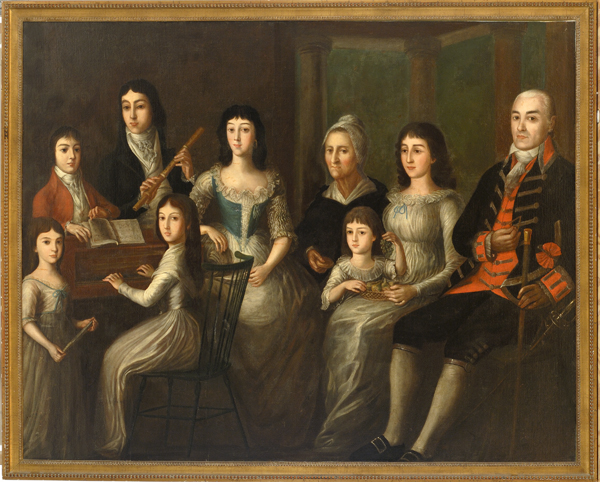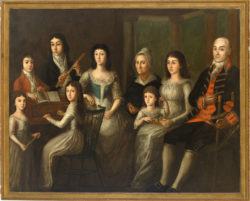José Francisco Xavier de Salazar y Mendoza
José Francisco Xavier de Salazar y Mendoza was a Spanish portraitist in colonial Louisiana.

Courtesy of Louisiana State Museum
Portrait of Montegut Family. Salazar, José Francisco Xavier de (Artist)
One name emerges consistently in the study of Spanish colonial painting in Louisiana: José Francisco Xavier de Salazar y Mendoza. In 1782, Salazar arrived in New Orleans from Mérida in the Yucatán. For the next two decades, he produced a visual record of Louisiana’s prominent civic, military, and religious leaders, including Andrés Almonester y Roxas, Padre Antonio de Sedella, Bishop Luís de Peñalver y Cárdenas, and Carlos Trudeau, the first surveyor general during Spanish domination. Salazar’s circa 1797 painting of the socially prominent Dr. Joseph Montegut, his wife, her aunt, and six children is the only known group portrait from early nineteenth-century Louisiana.
Pending the discovery of records in Mexico, little is known of Salazar’s early life and artistic training. His work, however, suggests that he arrived in Louisiana as a mature artist. Salazar’s technical proficiency in compositional complexity, as well as his awareness of Mexican and European painting traditions, is evidenced by the survival of his portraits for more than two hundred years. He arranged most of his subjects frontally or in three-quarter view (halfway between a front and a side view) against a dark monochromatic background. Characterized by even lighting and a limited palette, Salazar’s portraits often feature warm accents in skin tones. The shimmering transparent glazes resemble those of Goya, particularly in Salazar’s portraits of women in lace-trimmed silvery blue gowns. In these portraits, he often includes upholstery, flowers, and symbolic attributes. He reveled in depicting bold red military uniforms with gold trim, as in the circa 1797 double portrait of Captain Julien Vienne and his son, Julien George Vienne.
The Salazar Family
Salazar was the son of Salvador de Salazar and Feliciana Ojeda y Bazquez. While living in Yucatán, Salazar married Maria Antonia Magaña, who was the daughter of Antonio Magaña y La Cerda and Francisca Xaviera del Hollós Conejo, an islaña. Francisca, their daughter, was born in Yucatán, as was José, their second child, who was born in 1781. The Salazar family relocated to New Orleans in 1782. In 1784, José Casiano was born, the first child born to an artist in the colony. Under her father’s tutelage, Francisca was the first artist to study in Louisiana.
Like many of the city’s residents, the Salazar family was left homeless after the fire of 1788 destroyed most of the city. The 1791 Patrón, or census, lists their address as St. Philip Street, where the couple’s youngest child, Ramon Rafael de la Crus, was born. José Casiano and Ramon were both baptized in St. Louis Church (now known as St. Louis Cathedral). Their mother, Maria, died on June 24, 1793, and nine-year-old José Casiano died the following day. This near-simultaneous death of mother and child suggests that the cause was probably yellow fever, which plagued the city through the nineteenth century.
Drawing problems and inconsistencies in Salazar’s painting style suggest possible collaboration with his daughter, Francisca de Salazar y Magaña, and/or his son José. In 1796, Francisca married Pedro Gordillo, a sergeant in a Spanish colonial cavalry regiment, but she signed her work as “Franca Salazar” even after her marriage. In 1801, Francisca painted a copy of her father’s portrait of Bishop Luís de Peñalver y Cárdenas, which was intended for St. Louis Cathedral. Her only known signed painting, the portrait was destroyed in the 1988 Cabildo fire. It is quite possible that Francisca contributed to, or even created, some of the seventy extant paintings attributed to her father, perhaps including the original portrait of the bishop.
Conclusion and Significance
Evidently being in poor health, Salazar made out his will on March 4, 1801. He died seventeen months later on August 15, 1802. In his will, the José Salazar referred to José and Ramon as his “minor sons” and named his son-in-law, Gordillo, as their guardian. Francisca’s name appears in court records during the probate of her father’s will, the last mention of the Salazar family in any Louisiana archive. The fate of surviving family members after the Louisiana Purchase is unknown.
Salazar survived and thrived at a time when few artists ventured into the fledgling Louisiana colony. The 1791 census records list only two other painters in New Orleans, Joseph Furcoty and Joseph Herrara. This is the only mention of these two artists, of whom nothing else is known. Salazar’s paintings, which provide a rare historic glimpse into life in this difficult colony, are the only works from this period still in existence.
